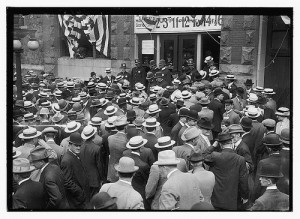Summary: 3 Features in Successful Cultural Heritage Outreach Events

The following reflections summarize features of cultural heritage outreach and engagement events I have attended during my recent fieldwork at the Smithsonian Institution. I have selected three overlapping features that appear to have contributed to the success of these cultural heritage events; in an upcoming post, I will also offer several tips for improving upon these outreach strategies.
Crowdsourcing
[Gathering or requestion information and action from the crowd, audience, or user]These engagement events have been predominately in line with a citizen-scientist model or crowdsourcing model. In other words, they have gathered participation on an avocational and/or volunteer basis. They have also operated in systematic ways to collect, refine, populate, and assign values – “doing things” with materials. The events have not necessarily been science-focused, though some have been. Most have required participants to BYOD and register for participation. Several of the events have also gathered experiential information and viewpoints from participants at the close of the event.
Participatory
[Audiences or individuals “opting in” toward a goal, either personal or collective]These outreach events have been based around the idea of a shared experience of working toward a project goal – calling upon a sense of participatory culture or being creator-consumers. That means that participants have been taking actions (“doing”) toward both individual projects and shared roles or group work toward parts of a goal, whilethe event has taken participants toward achieving a collective goal in the end.
Free but exclusive
[No charge but cost of time and some bounding on event]Each of these events were held by cultural heritage institutions and were free to attend; yet, the events were also managed in a way that was bounded in number, space, or access. Clarifying my use of “exclusive” to mean selective in this context, the events have typically accepted the first candidates for participation and allowed those individuals to feel as though they are gaining unique access in some way.
The three features discussed above appear to have subtly informed approaches and agenda; and resulted in events that appeared to be reasonably successful.* Enthusiastic and engaged participants were found at all events and activities taken toward each event’s stated goals.
Despite the appearances of success for these events, each event offered several points at which engagement or efficiency could be improved. Watch this space for an upcoming post that speaks to four ways best practice at cultural heritage outreach events can be built.
*This assumption made without knowledge of each event’s stated metrics for success.
**Image of crowds outside the entrance of the 1912 Republican National Convention held at the Chicago Coliseum, Chicago, Illinois, June 18-22, 1912 – shared from George Grantham Bain Collection (Library of Congress) – via Flickr Commons

